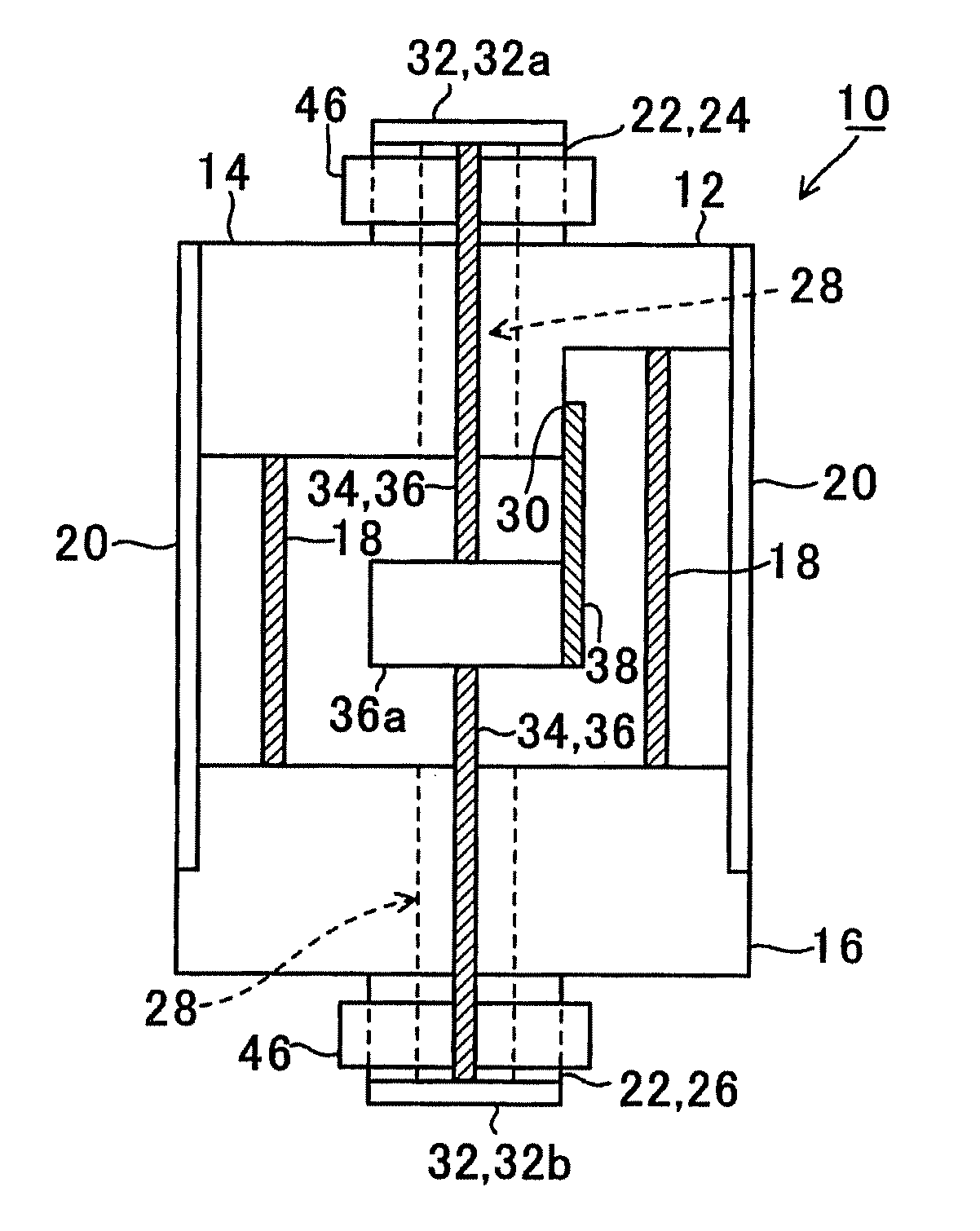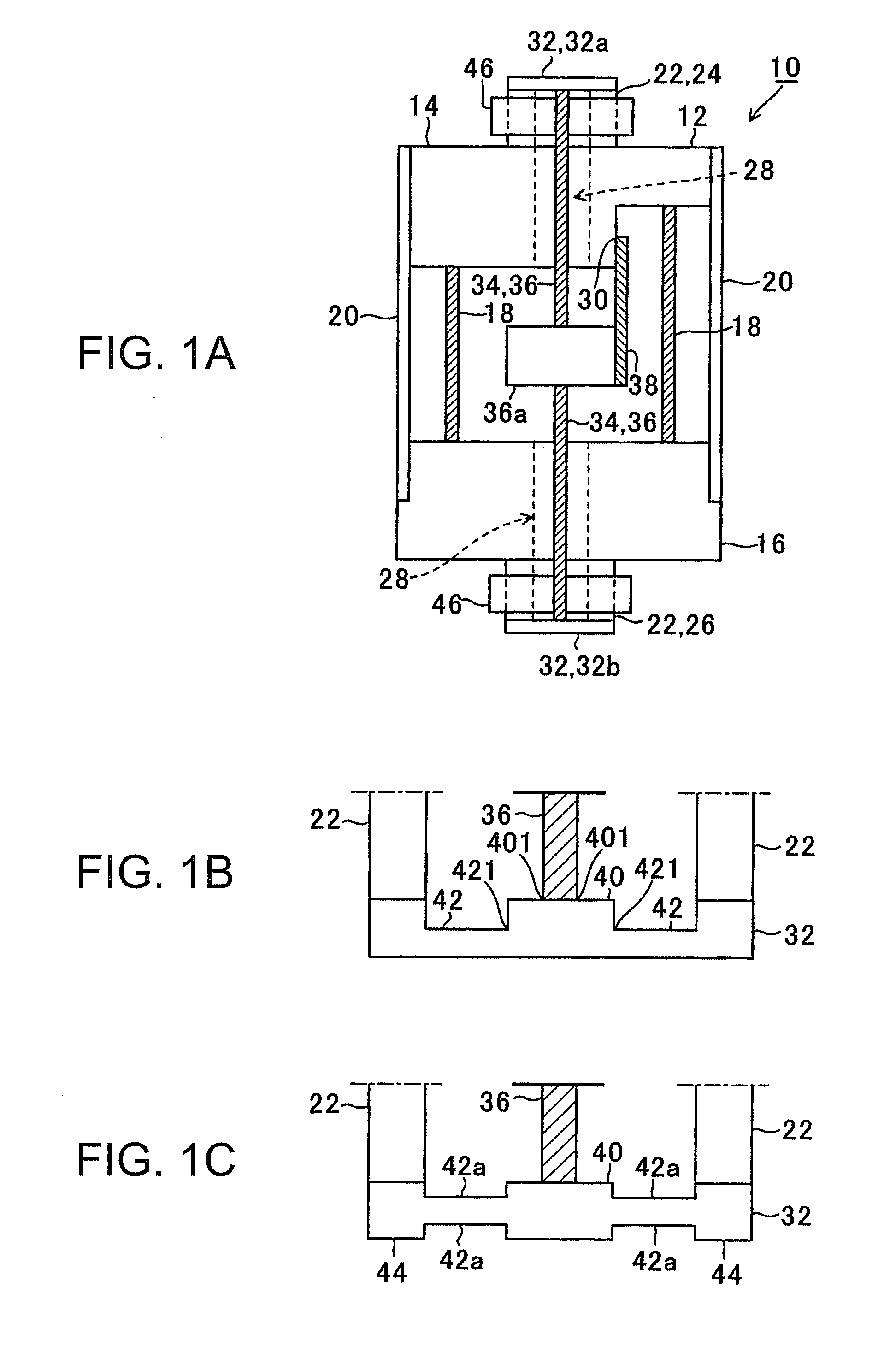Pressure sensor
a pressure sensor and sensor technology, applied in the field of pressure sensors, can solve the problems of thermal distortion of the elements, disadvantageous degradation of the characteristics of the pressure sensor, and error of a measured pressure value, and achieve the effects of reducing the number of steps, low cost and high yield
- Summary
- Abstract
- Description
- Claims
- Application Information
AI Technical Summary
Benefits of technology
Problems solved by technology
Method used
Image
Examples
first embodiment
[0105]As is understood from the above description, the pressure sensor does not use oil as an element. Therefore, a problem such as oil leakage does not occur. Also, the force transmitting unit 34 transmits a force only in the direction of the end surfaces of the pressure sensitive element 38, so the sensitivity of the pressure sensor 10 is improved. Also, stress is concentrated not only on a circumference 401 of the portion where the force transmitting unit 34 and center area 40 make contact with each other but also on a circumference 421 of the center area 40, that is, the boundary between the center area 40 and thin portion 42. Thus, the concentration of stress on the portion where the diaphragm 32 and force transmitting unit 34 make contact with each other is reduced and the stress is reliably transmitted to the force transmitting unit 34. As a result, the sensitivity of the pressure sensor 10 is improved. Also, aged deterioration due to repeated stress concentration is reduced...
fourth embodiment
[0118]In the fourth embodiment, the hermetic terminal board 114 is used as the upper end face plate and a hermetic terminal 160 is passed through the hermetic terminal board 114 so that a signal generated by the pressure sensitive element 138 is taken out.
[0119]By adopting the fourth embodiment having such a configuration, the pair of diaphragms 132 are coupled via the center shaft 136, and the movable unit 157 provided on the intermediate portion of the center shaft 136 moves (this movement is a movement attributable to the difference between the pressures received by the pair of diaphragms 132A and 132B) in the shaft axis direction in accordance with the movement of the diaphragms 132, together with the center shaft 136. This movement generates an acting force of the pressure sensitive element138, which is a double-sided fork tune resonator, in the detecting axis direction. As a result, there is formed a pressure sensor that uses no oil and has high detecting accuracy and that is ...
fifth embodiment
[0124]In the pressure sensor 200 the circumferential groove 242 is dug into both surfaces of an area surrounding a center area 240 of each diaphragm 232, and the center area 240 and a peripheral area 244 are thick portions and the portion on which the circumferential groove 242 is made is relatively thin. Therefore, if each diaphragm 232 receives pressure and thus becomes distorted, the flatness of the center area 240 thereof is maintained. Thus, a force in the axis direction is more accurately transmitted to the center shaft 136 connected to the center area 240. As a result, the detecting accuracy is improved. In particular, the front surface and back surface of each diaphragm 232 are symmetrical, so the diaphragms 232 are very easy to assemble as components.
[0125]FIG. 11 shows a sectional view of a pressure sensor 300 according to a sixth embodiment of the invention. In an example shown in the drawing, there is shown a pressure sensor that is intended to detect an absolute pressu...
PUM
| Property | Measurement | Unit |
|---|---|---|
| thicknesses | aaaaa | aaaaa |
| thicknesses | aaaaa | aaaaa |
| thicknesses | aaaaa | aaaaa |
Abstract
Description
Claims
Application Information
 Login to View More
Login to View More - R&D
- Intellectual Property
- Life Sciences
- Materials
- Tech Scout
- Unparalleled Data Quality
- Higher Quality Content
- 60% Fewer Hallucinations
Browse by: Latest US Patents, China's latest patents, Technical Efficacy Thesaurus, Application Domain, Technology Topic, Popular Technical Reports.
© 2025 PatSnap. All rights reserved.Legal|Privacy policy|Modern Slavery Act Transparency Statement|Sitemap|About US| Contact US: help@patsnap.com



